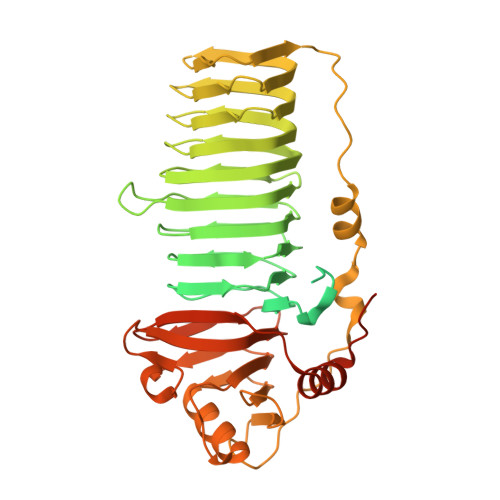Comparative Biochemical and Structural Analysis of Novel Cellulose Binding Proteins (Tapirins) from Extremely ThermophilicCaldicellulosiruptorSpecies.
Lee, L.L., Hart, W.S., Lunin, V.V., Alahuhta, M., Bomble, Y.J., Himmel, M.E., Blumer-Schuette, S.E., Adams, M.W.W., Kelly, R.M.(2019) Appl Environ Microbiol 85
- PubMed: 30478233
- DOI: https://doi.org/10.1128/AEM.01983-18
- Primary Citation of Related Structures:
6N2B, 6N2C - PubMed Abstract:
Genomes of extremely thermophilic Caldicellulosiruptor species encode novel cellulose binding proteins, called tāpirins, located proximate to the type IV pilus locus. The C-terminal domain of Caldicellulosiruptor kronotskyensis tāpirin 0844 (Calkro_0844) is structurally unique and has a cellulose binding affinity akin to that seen with family 3 carbohydrate binding modules (CBM3s). Here, full-length and C-terminal versions of tāpirins from Caldicellulosiruptor bescii (Athe_1870), Caldicellulosiruptor hydrothermalis (Calhy_0908), Caldicellulosiruptor kristjanssonii (Calkr_0826), and Caldicellulosiruptor naganoensis (NA10_0869) were produced recombinantly in Escherichia coli and compared to Calkro_0844. All five tāpirins bound to microcrystalline cellulose, switchgrass, poplar, and filter paper but not to xylan. Densitometry analysis of bound protein fractions visualized by SDS-PAGE revealed that Calhy_0908 and Calkr_0826 (from weakly cellulolytic species) associated with the cellulose substrates to a greater extent than Athe_1870, Calkro_0844, and NA10_0869 (from strongly cellulolytic species). Perhaps this relates to their specific needs to capture glucans released from lignocellulose by cellulases produced in Caldicellulosiruptor communities. Calkro_0844 and NA10_0869 share a higher degree of amino acid sequence identity (>80% identity) with each other than either does with Athe_1870 (∼50%). The levels of amino acid sequence identity of Calhy_0908 and Calkr_0826 to Calkro_0844 were only 16% and 36%, respectively, although the three-dimensional structures of their C-terminal binding regions were closely related. Unlike the parent strain, C. bescii mutants lacking the tāpirin genes did not bind to cellulose following short-term incubation, suggesting a role in cell association with plant biomass. Given the scarcity of carbohydrates in neutral terrestrial hot springs, tāpirins likely help scavenge carbohydrates from lignocellulose to support growth and survival of Caldicellulosiruptor species. IMPORTANCE The mechanisms by which microorganisms attach to and degrade lignocellulose are important to understand if effective approaches for conversion of plant biomass into fuels and chemicals are to be developed. Caldicellulosiruptor species grow on carbohydrates from lignocellulose at elevated temperatures and have biotechnological significance for that reason. Novel cellulose binding proteins, called tāpirins, are involved in the way that Caldicellulosiruptor species interact with microcrystalline cellulose, and additional information about the diversity of these proteins across the genus, including binding affinity and three-dimensional structural comparisons, is provided here.
Organizational Affiliation:
Department of Chemical and Biomolecular Engineering, North Carolina State University, Raleigh, North Carolina, USA.















